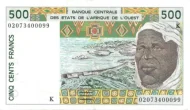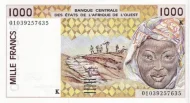Exchange your CFA francs West Africa
Do you have leftover CFA Francs from West Africa? We offer a fast and easy way to exchange both current and withdrawn CFA Franc banknotes and coins. Convert them into your local currency today with our quick and convenient exchange service.
CFA - XOF
The CFA Franc has been the official currency of eight West African countries since 1945, providing stability through its peg to the Euro.
CFA francs West Africa Information
The CFA Franc (XOF) is the official currency of eight West African countries that are part of the West African Economic and Monetary Union (WAEMU), including Benin, Burkina Faso, Ivory Coast, Guinea-Bissau, Mali, Niger, Senegal, and Togo. Like its counterpart in Central Africa (XAF), the CFA Franc used in West Africa is guaranteed by a fixed exchange rate with the Euro, providing a stable currency for the region. The CFA Franc has been in use since 1945, when it was introduced as a replacement for the Fr…
The CFA Franc is subdivided into 100 centimes, and the currency is issued in both coins and banknotes. Coins are available in denominations of 1, 5, 10, 25, 50, 100, and 500 francs, while banknotes are issued in denominations of 500, 1,000, 2,000, 5,000, and 10,000 francs. The designs on CFA Franc banknotes often feature images that reflect the cultural and economic diversity of the region, including depictions of agricultural activities, local architecture, and important historical figures.
The CFA Franc is pegged to the Euro at a fixed exchange rate of 655.957 XOF to 1 EUR. This arrangement has provided a high level of stability to the currency, even during periods of global economic volatility. The currency peg ensures that the CFA Franc remains stable, making it easier for member countries to engage in trade with each other and with international partners. The backing of the French Treasury guarantees the convertibility of the CFA Franc into Euros, which provides additional confidence…
One of the key benefits of using the CFA Franc is the economic integration it facilitates among member countries. By using a common currency, WAEMU countries are able to avoid the costs and complexities associated with currency exchange, making cross-border trade and investment more efficient. The common currency has helped to promote economic cooperation and development in the region, contributing to greater economic stability and growth.
The management of the CFA Franc in West Africa is overseen by the Central Bank of West African States (BCEAO), which is responsible for issuing currency, regulating monetary policy, and maintaining financial stability within the region. The BCEAO operates under a currency board arrangement, ensuring that the amount of CFA Francs in circulation is fully backed by foreign currency reserves, primarily in Euros. This system helps to maintain confidence in the currency and ensures its stability over time.
Despite the benefits provided by the CFA Franc, there has been ongoing debate about the currency’s future. Some critics argue that the currency arrangement limits the monetary sovereignty of member countries, as they have limited control over their own monetary policy. Others see the CFA Franc as a remnant of colonialism, given its historical ties to France. In response to these concerns, there have been discussions about potentially reforming or replacing the CFA Franc with a new currency that would g…
In conclusion, the CFA Franc has been the official currency of eight West African countries since 1945. Its stability, guaranteed by its peg to the Euro, has contributed to economic integration and growth in the region, and it remains a crucial part of the financial system in West Africa.





